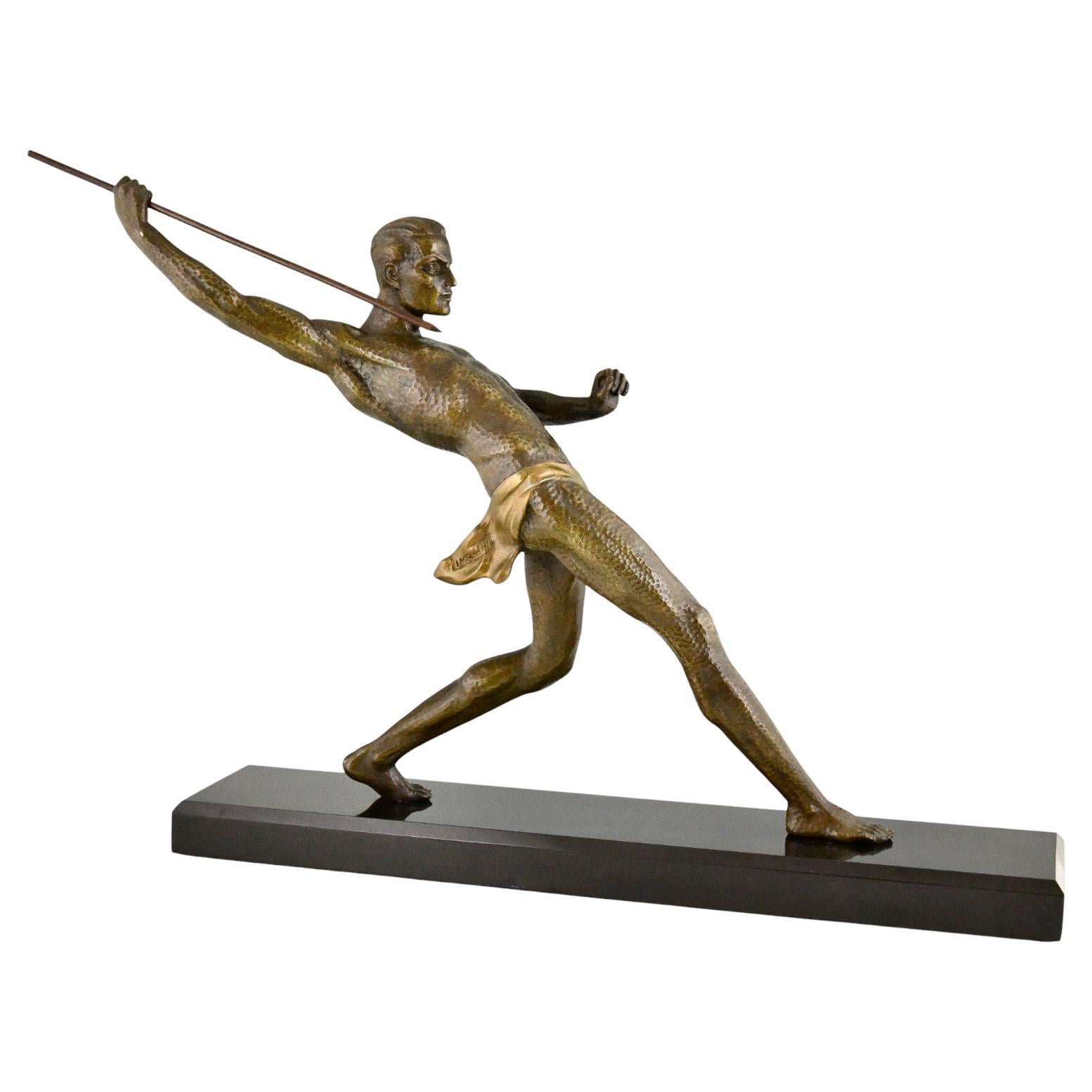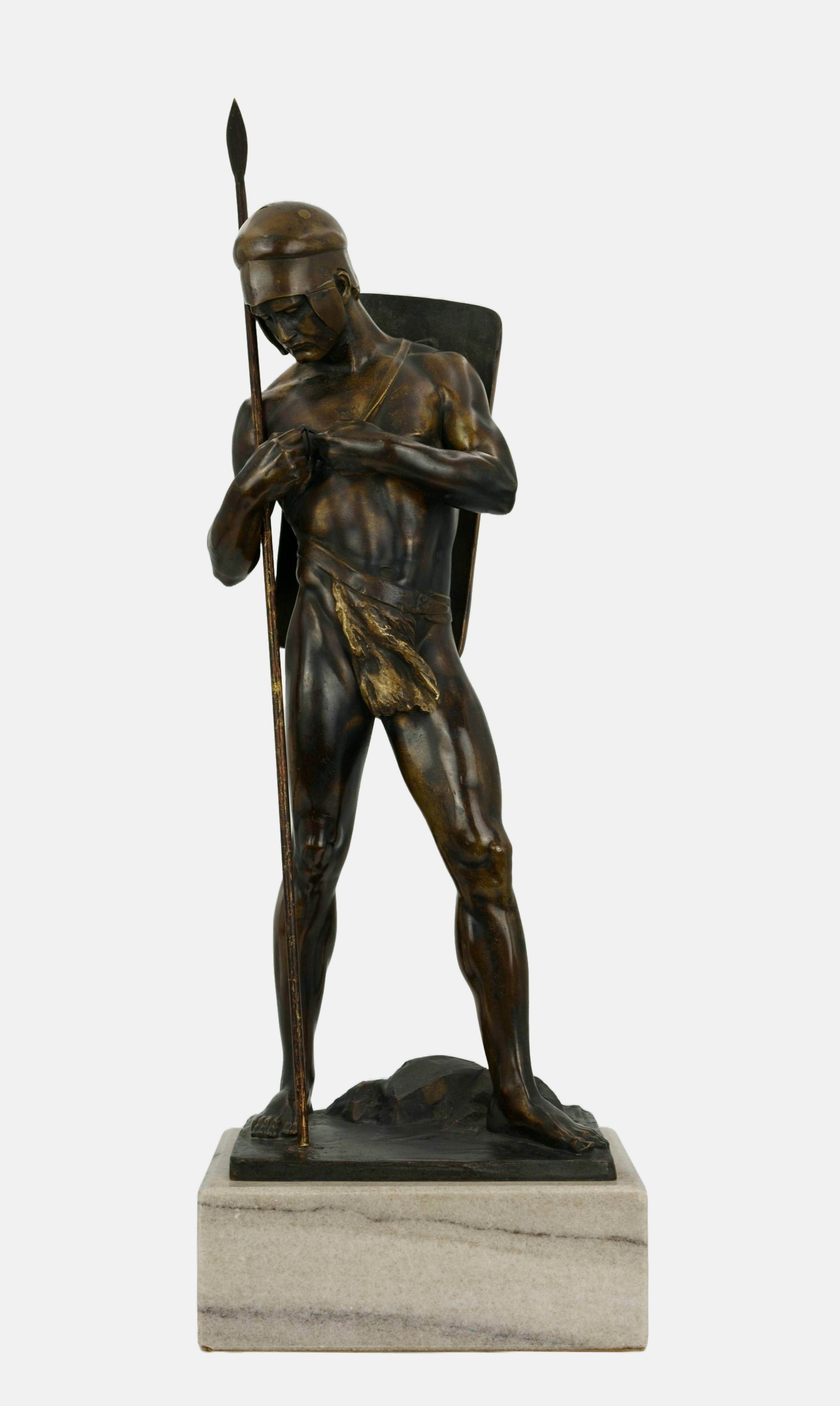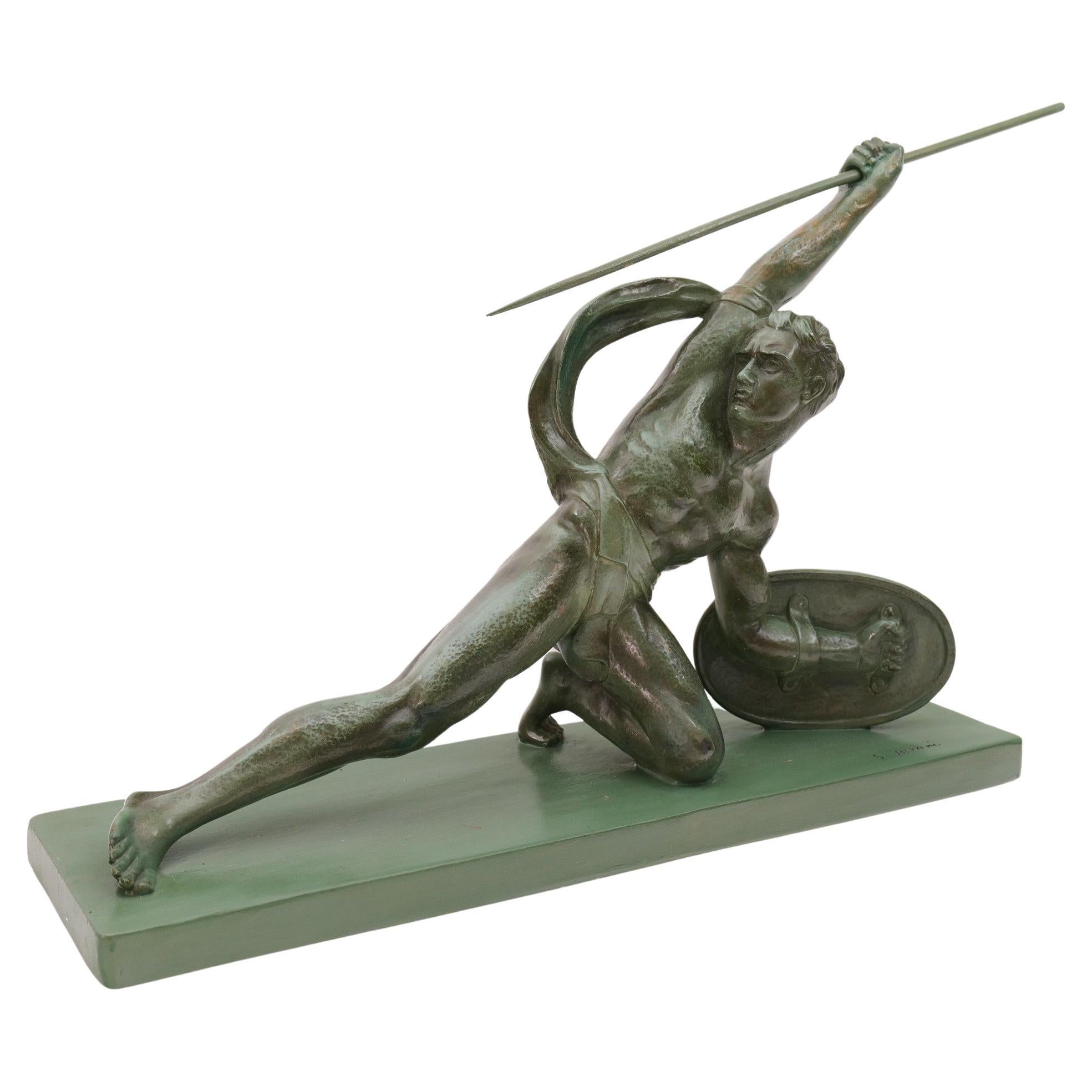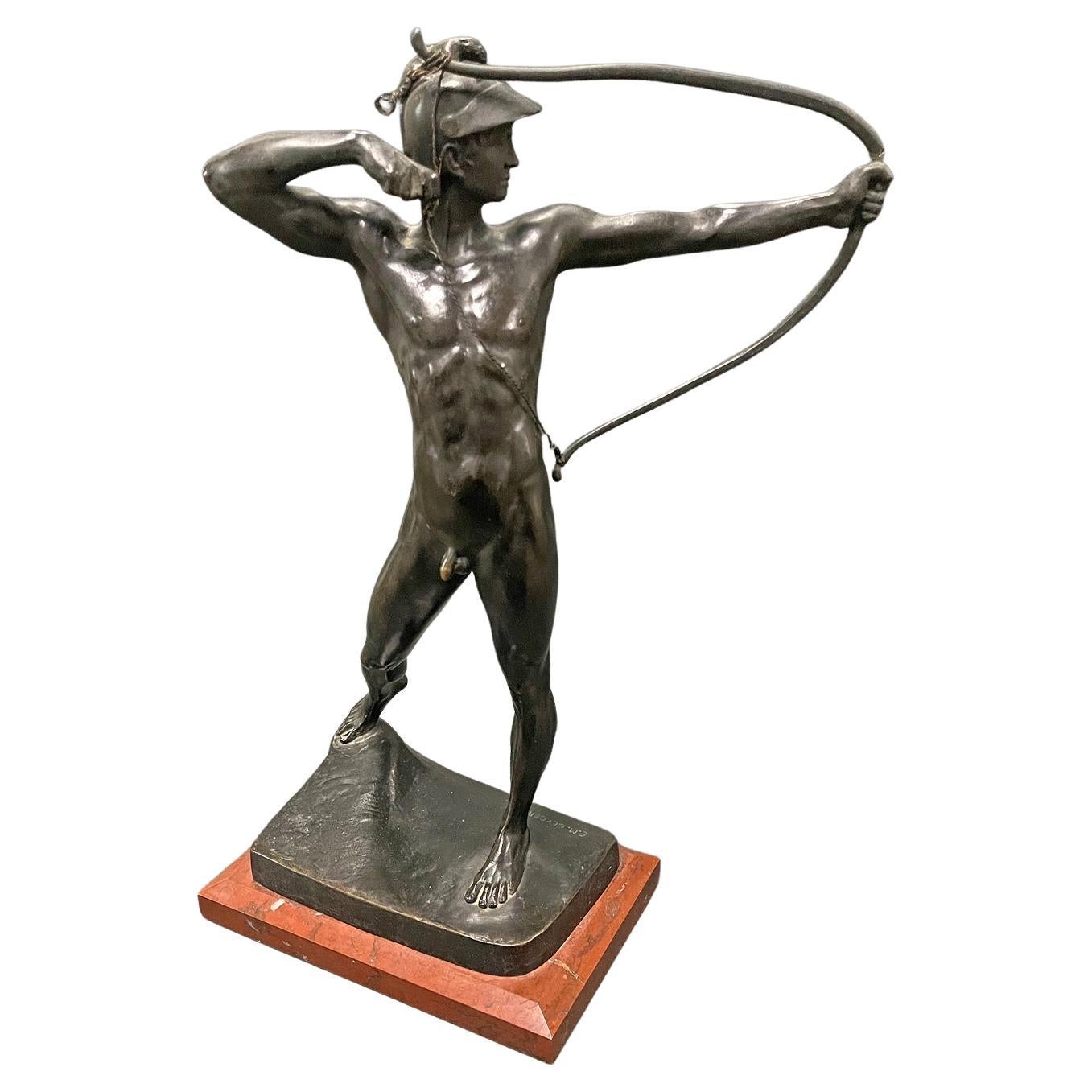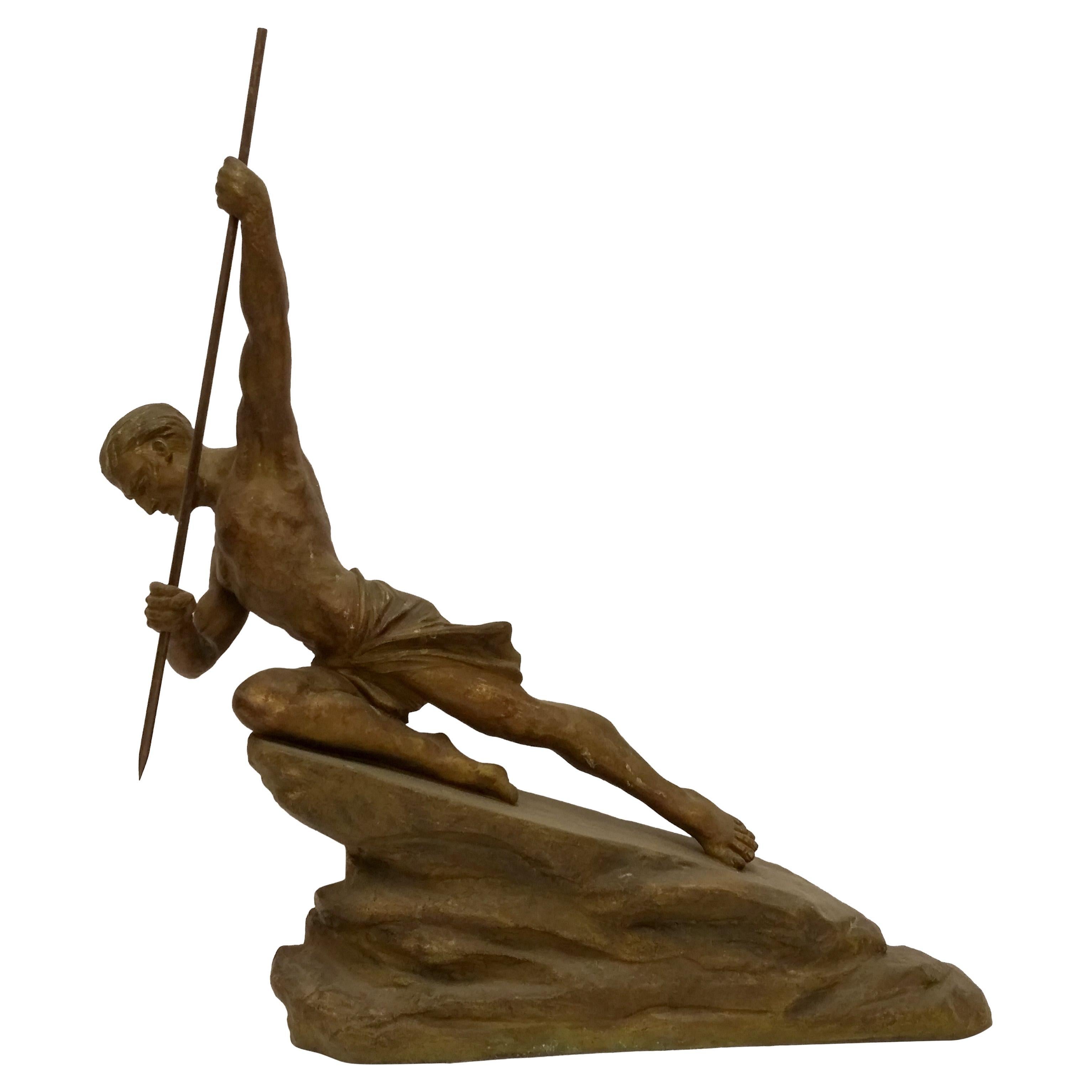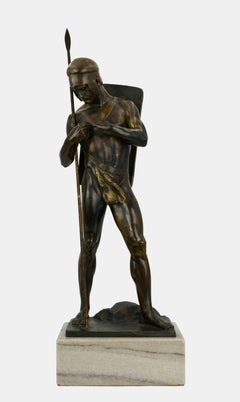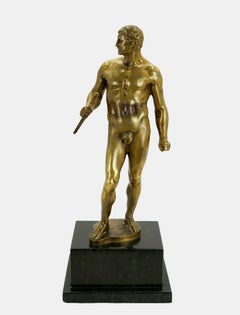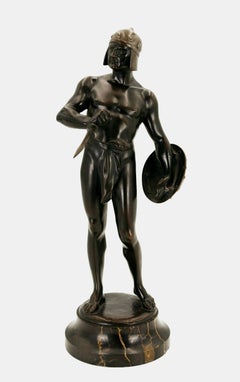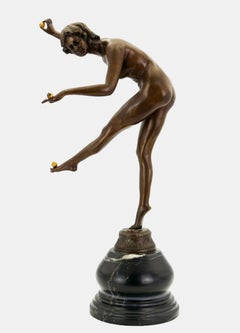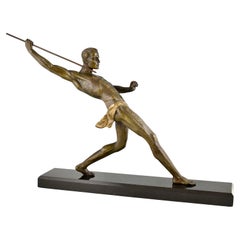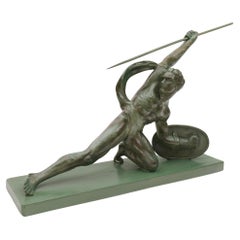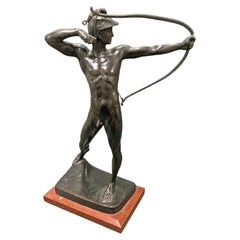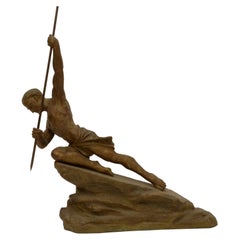Items Similar to Javelin thrower / - Roman present -
Want more images or videos?
Request additional images or videos from the seller
1 of 9
Franz IfflandJavelin thrower / - Roman present -after 1910
after 1910
$2,408.37
$3,010.4720% Off
£1,781.89
£2,227.3720% Off
€2,000
€2,50020% Off
CA$3,330
CA$4,162.5020% Off
A$3,655.93
A$4,569.9120% Off
CHF 1,907.31
CHF 2,384.1320% Off
MX$44,241.83
MX$55,302.2920% Off
NOK 23,905.12
NOK 29,881.4020% Off
SEK 22,524.91
SEK 28,156.1320% Off
DKK 15,228.06
DKK 19,035.0720% Off
About the Item
Franz Iffland (1862 Tempelhof - 1935 Berlin), Javelin thrower, after 1910. Olive-black patinated bronze with cast plinth mounted on a white-veined black marble base (7 cm high). Total height 61 cm. Dimensions of the bronze without spear: 46 cm (height) x 26 cm (width) x 25 cm (depth), length of the removable spear: 58 cm, weight 4.8 kg. Signed “Iffland” on the plinth.
- The calf of the left leg with a small restored area, patina with scratch mark at the point where the spear is attached to the head, very occasionally somewhat rubbed.
- Roman present -
As part of the physical culture that emerged in the 19th century and the popular sport that developed from it, the athlete became the new hero. In 1894, the Olympic Games were re-established, with athletics as the supreme discipline, in keeping with the ancient tradition. The javelin thrower is also associated with this. Iffland did not portray an athlete of his time, but rather the epitome of the athlete. The javelin thrower has raised his fist in triumph as he comes to a stop and looks up as if he has reached his goal. His concise facial expression is still marked by the will to win, and the immense javelin bears witness to his almost superhuman performance. His entire body displays a muscular agility that would allow him to master any other discipline.
The short haircut, combed forward, reminiscent of Caesar, and the Roman nose with its pronounced hump do not refer to Athens but to ancient Rome, so that the gesture and the gaze also have the character of the Caesar salute, which had become established as the Olympic salute in Iffland's time. Through the jersey and shoes, Iffland's athlete also refers to the present, with which the artist makes clear that the ideals of Roman antiquity should be carried into the present through sport.
About the artist
Even though Franz Iffland's work and biography have remained unexplored by art historians to this day, the Berlin sculptor was one of the most popular creators of domestic bronze sculptures of his time, who helped shape both Art Nouveau and Art Deco. He was regularly represented at the exhibitions of the Berlin Art Academy from 1862 and presented his works at the International Art Exhibition in 1891 and the Great Berlin Art Exhibition in 1893.
GERMAN VERSION
Franz Iffland (1862 Tempelhof - 1935 Berlin), Speerwerfer, nach 1910. Olivschwarz patinierte Bronze mit gegossener Plinthe auf weiß geädertem schwarzem Marmorsockel (7 cm Höhe) montiert. Gesamthöhe 61 cm. Maße der Bronze ohne Speer: 46 cm (Höhe) x 26 cm (Breite) x 25 cm (Tiefe), Länge des abnehmbaren Speers: 58 cm, Gewicht 4,8 kg. Auf der Plinthe mit „Iffland“ signiert.
- An der Wade des linken Beins mit kleiner restaurierter Stelle, Patina mit Kratzspur an der Ansatzstelle des Speeres am Kopf, sehr vereinzelt etwas berieben.
- Römische Gegenwart -
Im Rahmen der im 19. Jahrhundert aufkommenden Körperkultur und dem sich daraus entwickelndem Breitensport wurde der Athlet zum neuen Heros. 1894 wurden die Olympischen Spiele wiederbegründet, bei denen – in antiker Tradition – die Leichtathletik als Königsdisziplin galt. In diesem Zusammenhang steht auch der Speerwerfer. Iffland hat hier keinen Sportler seiner Zeit porträtiert, sondern den Inbegriff des Athleten geschaffen. In einer zum Stehen kommenden Vorwärtsbewegung hat der Speerwerfer siegreich seine Faust erhoben und den Blick in die Höhe gerichtet, als ob er das anvisierte Ziel erreicht hätte. Seine prägnant ausgeformte Mimik ist noch ganz vom Siegeswillen geformt und der immense Speer zeugt von der schier übermenschlichen Leistung. Sein ganzer Körper weist eine muskulöse Agilität auf, die ihn auch alle anderen Disziplinen meistern lassen würde.
Der an Cäsar gemahnende nach vorne gekämmte Kurzhaarschnitt und die römische Nase mit dem ausgeprägten Höcker verweisen nicht nach Athen, sondern in das antike Rom, so dass die Handhaltung und der Blick zugleich den Charakter des Caesarengrußes hat, der sich zur Zeit Ifflands als Olympischer Gruß etabliert hatte. Durch das Trikot und die Schuhe bezieht sich auch Ifflands Athlet auf seine gegenwärtige Zeit, womit der Künstler verdeutlicht, dass die Ideale der römischen Antike durch den Sport in die Gegenwart getragen werden sollten.
zum Künstler
Auch wenn das Werk und die Biographie Franz Ifflands bis heute kunsthistorisch unerschlossen geblieben ist, war der Berliner Bildhauer einer der populärsten Schöpfer häuslicher Bronzeplastiken seiner Zeit, der sowohl den Jugendstil als auch das Art déco mitprägte. Er war ab 1862 regelmäßig auf den Ausstellungen der Berliner Kunstakademie vertreten und präsentierte 1891 seine Werke auf der Internationalen und 1893 auf der Großen Berliner Kunstausstellung.

About the Seller
5.0
Vetted Professional Seller
Every seller passes strict standards for authenticity and reliability
Established in 2014
1stDibs seller since 2023
21 sales on 1stDibs
- ShippingRetrieving quote...Shipping from: Berlin, Germany
- Return Policy
Authenticity Guarantee
In the unlikely event there’s an issue with an item’s authenticity, contact us within 1 year for a full refund. DetailsMoney-Back Guarantee
If your item is not as described, is damaged in transit, or does not arrive, contact us within 7 days for a full refund. Details24-Hour Cancellation
You have a 24-hour grace period in which to reconsider your purchase, with no questions asked.Vetted Professional Sellers
Our world-class sellers must adhere to strict standards for service and quality, maintaining the integrity of our listings.Price-Match Guarantee
If you find that a seller listed the same item for a lower price elsewhere, we’ll match it.Trusted Global Delivery
Our best-in-class carrier network provides specialized shipping options worldwide, including custom delivery.More From This Seller
View AllSpear Fighter / - The Fighter's Concentration -
Located in Berlin, DE
Ludwig Eisenberger (active in Berlin between 1895-1920), Spear Fighter, around 1910. Brown patinated bronze with residual gilding on a cast terrain plinth with marble base (8 cm high...
Category
1910s Realist Nude Sculptures
Materials
Bronze
Naked warrior with short sword / - The New Hercules -
Located in Berlin, DE
Hermann Volz (1847 Karlsruhe - 1914 ibid.), Naked warrior with short sword, c. 1935. Partially (?) patinated bronze with cast plinth mounted on a black marble base (6.8 cm high). 32....
Category
1930s Art Deco Nude Sculptures
Materials
Bronze
Gladiator ready for battle / - Ready for anything -
By Bruno Zach
Located in Berlin, DE
Bruno Zach (1891 Zhitomir - 1945 Vienna), Gladiator ready for battle, c. 1930. Blackish patinated bronze with silver-plated helmet, shield rim and shield pommel mounted on a fluted m...
Category
1930s Art Deco Nude Sculptures
Materials
Bronze
Juggler / - Artistic naturalness -
Located in Berlin, DE
Claire Jeanne Robertine Colinet (1880 Brussels - 1950 Asnières-sur-Seine), Juggler, around 1920. Brownish patinated bronze with gilded balls on a round, multi-profiled stone base (10...
Category
1920s Art Deco Nude Sculptures
Materials
Bronze
Crusader with shield and mace / - Ready to strike -
Located in Berlin, DE
Josef Moest (1873 Cologne - 1914 Rath), Crusader with shield and mace, around 1910. Bronze on a black marble pedestal (19 cm high). 57.5 cm (total height) x 21 cm (width) x 12 cm (de...
Category
1910s Realist Figurative Sculptures
Materials
Bronze
Field worker with rake / - The Humility of the Farm Worker -
Located in Berlin, DE
Paul Ludwig Kowalczewski (1865 Mieltschin - 1910 Berlin), Field worker with rake, around 1900. Brown and brown-greenish patinated bronze with ...
Category
Early 1900s Realist Figurative Sculptures
Materials
Bronze
$1,541 Sale Price
20% Off
You May Also Like
Art Deco sculpture athlete with spear javelin thrower signed by Limousin, 1930.
By Limousin
Located in Antwerp, BE
Art Deco sculpture athlete with spear, javelin thrower signed by Limousin.
Patinated Art Metal on a Belgian Black marble base. France 1930.
Category
Vintage 1930s French Art Deco Figurative Sculptures
Materials
Belgian Black Marble, Metal
French 1930s Art Deco Sculpture Man with Spear by Salvatore Melani
By Salvatore Melani
Located in Saarbrücken, SL
Signed by Salvatore Melani - 1930
Dimension:
47 cm width
42 cm heigh
Material:
Plaster.
Category
Vintage 1930s French Art Deco Figurative Sculptures
Materials
Sandstone
"Nude Male Archer, " Bronze by Geyger, Original Purchased by Kaiser Wilhelm II
Located in Philadelphia, PA
Brilliantly sculpted and cast with very fine detail with a rich, lustrous patina, this celebrated bronze of a fully nude male archer was sculpted by Ernst ...
Category
Antique Early 1900s German Belle Époque Figurative Sculptures
Materials
Bronze
French Art Deco Hunter with a spear Sculpture by R. Varnier
By R. Varnier
Located in Long Island City, NY
A French Art Deco hunter with a spear sculpture in green golden patina by the French artist R. Varnier. In great condition with modest wear commensurate with...
Category
Early 20th Century French Art Deco Figurative Sculptures
Materials
Tin
$850 Sale Price
70% Off
Art Deco bronze sculpture athlete with spear by Pierre Le Faguays France 1927
By Pierre Le Faguays
Located in Antwerp, BE
Art Deco bronze sculpture athlete with spear signed by Pierre Le Faguays.
The sculpture has a rich green patina with shades of brown.
France 1927.
This bronze is illustrated on page...
Category
Vintage 1920s French Art Deco Figurative Sculptures
Materials
Bronze
Art Deco bronze by Ludwif Eisenberger of man in a loin cloth with a rapier
Located in London, GB
Fine early 20th century Art deco period bronze of a fencer holding and bending his rapier. The well modelled figure is naked except for a loincloth and he is seen looking down and flexing the blade of his rapier. Ludwig Eisenberger...
Category
Vintage 1930s German Figurative Sculptures
Materials
Marble, Bronze
More Ways To Browse
Art Deco Bronze Sculpture Nude
Art Deco Sculpture Nude
Antique Bronze Nude
Art Deco Bronze Nude
Bronze Sculpture 1910
Bronze Spear
Dior Shoes Black And White
Antique Javelin
Phillip Russell
Piano Artwork
Planetary Folklore
Pomeranian Dog
Portrait Of Cows
Portrait Of Dora Maar
Raccoon Painting
Racing Race Painting
Richard Bankes Harraden
Robert Buck
